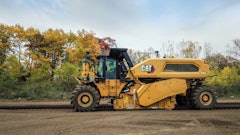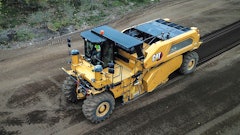
When working for a highway department of a rural county, often you have to make do with the equipment you have. Extremely tight road maintenance and operating budgets make it impossible to purchase new equipment with the features required to help maintain roads at an acceptable level.
Highway engineers do the best they can and stretch budgets as far as possible, but, frequently, this is not enough and a growing number of road lane miles fall into disrepair.
"We have 771 miles of roads in Carroll County (Indiana)," says Paul Couts, Carroll County highway engineer, “551 which are paved."
In a county of 20,000 people, this doesn't leave much of a budget for maintaining and upgrading roads. "We spend about $11,000 per lane-mile for road maintenance with our chip and seal program," he adds.
With a harsh winter transitioning the number of roads under his jurisdiction from Class 1 and 2 designations –good condition – to Class 3 and 4 designations – poor to failing condition (see box for full class explanation) – Couts needed a reclamation solution to rehabilitate a number or roads. Unfortunately, the old, tow-behind recycler the county highway department had in its fleet was outdated.
"The recycler we own is relatively small and pulled behind a farm tractor,” explains Couts. "We recycled a couple of roads with the old machine last year, but, because of its age, it wasn't very productive. We could not push it too hard without it overheating. Also, we couldn't reclaim very deep with the machine, and it had limited flexibility to adapt to the roads we were upgrading."
Aggressive road schedule requires updated equipment
Planning for the 2014 season with an increasing number of lane miles falling into disrepair, the Carroll County highway department set an aggressive schedule for upgrading roads. Couts targeted 19 miles – 38 lane miles – of county roads to upgrade to either a Class 1 or 2 designation. However, the county’s extremely tight budget would not allow for total reconstruction, and the old pull-behind recycler was more ready for retirement than upping its game.
Couts turned to Southeastern Equipment Co. Inc. of Ft. Wayne, IN, for help. Jeff Custer, sales rep for Southeastern Equipment, helped Couts find a reclamation solution.
"We see a number of road departments in the same situation as Carroll County," says Custer. "They have tight budgets and cannot afford to purchase large recycler/ stabilizer machines, so they either do the best they can with old equipment at their disposal or they purchase less expensive machines that either attach to loaders or are pulled by tractors."
While this can be a solution, the less productive machines come with several drawbacks. "These types of recyclers tie up an extra piece of equipment the county could be using elsewhere, and two machines, versus one, are guzzling many gallons of diesel fuel per hour, which adds to costs," says Custer. "Plus, counties lose a lot of flexibility, as these machines don't offer the options, gradation and depth control provided by a recycler/stabilizer like the BOMAG MPH364 R–2."
After listening to Carroll County’s needs, Southeastern Equipment representatives worked with Couts to get him equipment that would deliver the flexibility and productivity required to meet the aggressive road rehabilitation schedule. The distributor came up with a rental agreement to fit the county’s budget that included both the BOMAG MPH364R-2 recycler and BW177 PDH – 40 padfoot drum roller.
The Carroll County Council was able to transfer some funds from the Cumulative Bridge budget, and with some extra state money in motor vehicle highway (MVH), Couts was able to pursue his aggressive 19-mi (30.6-km) schedule. "One commissioner told me to rent it and get it done," says Couts. So he did.
Southeastern Equipment set up a monthly rental for both the MPH364R–2 and BW177–40 compactor.
"One benefit of the rental option is you can rent the full reclaimer/stabilizer that offers much more control over gradation and depth settings for multiple months versus buying an attachment recycler," says Custer. "Plus, you get local support from the distributor should you run into a question or need service and parts."
Upon delivery of the machine, Southeastern Equipment’s reps spent a half of a day training Carroll County operators on how to run the machine. They covered setting depth control, adjusting rotor door to control gradation and how the automatic power adjustment works on the hydrostatic drive among the many other features found on the machine. "Having the assistance on operating details and hands-on instructions were keys to helping us get the most from the machine," says Couts.
Project details
Carroll County’s crew set out to complete the road work with the new rented equipment. Couts targeted the worst of the failing Class 4 roads, which included primary county roads and local rural roads. Many of these roads are heavily traveled with truck traffic and agricultural equipment with maximum 80,000-lb loads.
The typical road for reclamation was an older chip and seal road with two lanes consisting of an approximate 18-ft. overall width. The BOMAG MPH364R–2 recycler offers a 79-in. rotor width to reduce the number of passes required.
"We completed the full two-lane road in three passes, one up each side and a finish passed down the center of the road," says Couts. Custer adds, "The MPH364R–2 offers a wider rotor width than many of the attachment recyclers counties can afford, so it completes the road in fewer passes."
One thing that varied on the roads was depth of the underlying aggregate. Some roads had only 3 to 4 in. of stone under the road surface, whereas others had as much as 8 in. of aggregate.
"We wanted to make sure we did not start digging into the soil, so being able to control the depth of cut with the recycler was a big benefit," says Couts.
For efficient reclamation of the old chip and seal roadways and highways, the BOMAG MPH364R-2 offers a maximum cutting depth of 12 in., so the road surface and underlying aggregates could be pulverized, reblended and graded in a single pass to boost efficiencies. The operator can select between two rotor speeds – 135 or 150 rpm – to adjust speed to site conditions. Its hydrostatic drive’s Automatic Proportioning Adjustment (APA) maintains optimum reclamation performance, based on rotor system load, while the drive’s ASC traction control system maintains tire grip when pulling through tough cuts.
For the more heavily traveled county roads, workers dumped and leveled approximately 4 in. of asphalt mailings in front of the MPH364R–2.
"We added the millings to create a more stable base, as the chip and seal does not add much stability," says Couts. Even with the millings in front of the machine, the recycler was able to chew through the old road at speeds reaching 187 fpm.
Part of the BOMAG one-two rental equipment punch for Carroll County, the BW177 PDH–2 padfoot single vibratory drum roller followed close behind the MPH364R–2 to give initial compaction for the recycled road. The single drum roller offers a 66.4-in (1686-mm) compaction width.
The drum’s dual frequency and amplitude vibratory system generates up to 30,375 lb. centrifugal force over the drum’s 15.3-in² pads to quickly gain specified densities. "The drum width and compaction force generated by the BW177PDH–40 enables the roller to keep up with the recycler, so productivity targets are maintained." Couts adds, "The padfoot roller was nice to have, as it compacted material better than the steel drum roller we typically use."
After this, the highway department crews topped the road with two layers of chip and seal. "The base layer consisted of a #9 aggregate (with a 0.75-in. top aggregate size) and the surface lift was a #11 aggregate (with a 0.5-in. top aggregate size),” says Couts.
Economically, the MPH364R–2 recycler helped Carroll County reclaim an upgrade 17 miles of roads during the six-week window they had for the repair season. Only heavy rains during this period and a transition to starting the chip and seal process for other county roads kept Carroll County workers from achieving the aggressive target. “The recycler gave us the productivity levels we expected,” mentions Couts.
What were once failing Class 4 roads in disrepair are now Class 1 or 2 roads that will require less maintenance over the years, saving money for taxpayers. "We have an eight-year chip and seal cycle on these roads and expect the newly upgraded roads will give us this service life," says Couts. By requiring fewer repairs, these upgraded roads will help us to stretch our budget dollars even further."
With the success achieved in 2014 using Southeastern Equipment’s BOMAG equipment rental program, Couts is already looking forward to 2015 and taking another bite out of the Class 4 roads in Carroll County.
"The Bomag machine is modern, has the required horsepower and offers good grade control," says Couts. "It met our production goals and was very easy to operate. We plan to include rental of the machine into next year's road maintenance budget."



















